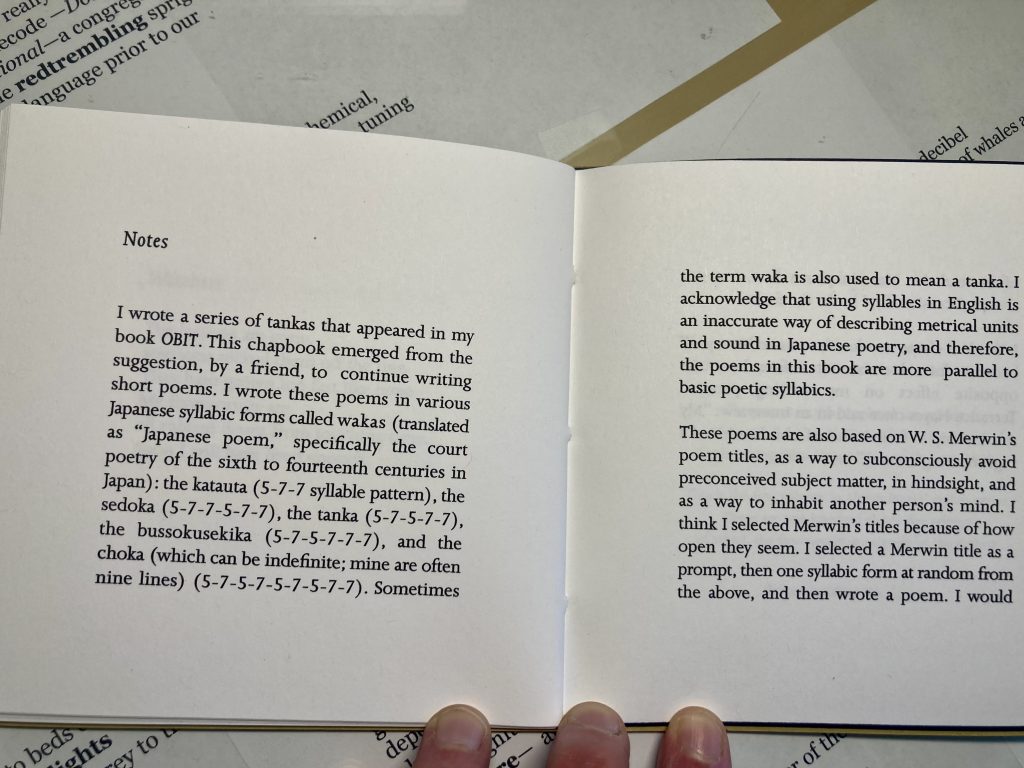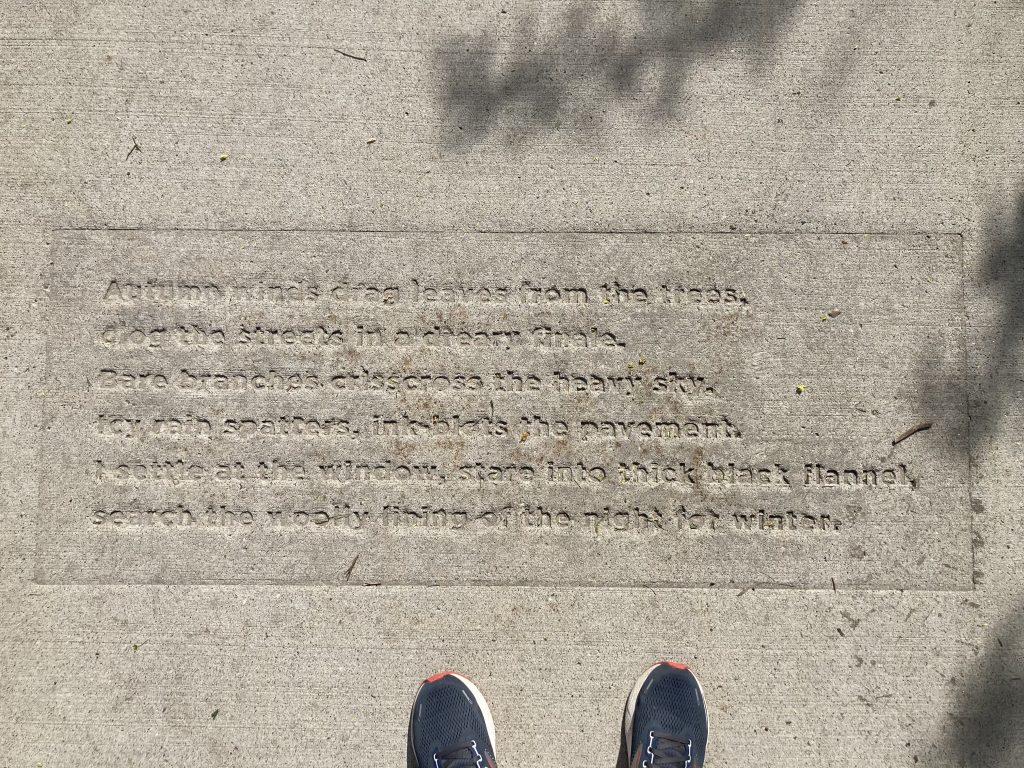3.25 miles
trestle turn around
78 degrees / dew point: 66
For the first mile, in the shade it felt almost cool or, at least not HOT! Hardly any bugs, but tons of chirping birds, one black-capped chickadee calling out for a response which never came. A few other runners, walkers, a group of bikers. After turning around at the trestle I passed by 3 women instructing a fourth on how to use an unfamiliar bike. Somewhere I smelled tobacco — from a car? below on the winchell trail? a walker’s clothes? Admired the glowing purple flowers on the edge of the trail and the stretch of the path that was all shade, except for a few splotches of light. One splotch was big enough to see my shadow in before we both disappeared into the shade. The river was calm and pale blue. The green was thick excess. The stretches of trail in the direct sun were warm. At least twice I pushed myself to keep running when I wanted to stop. At the trestle I put in my old “Winter” playlist
immersion
This summer I’m devoting a lot of attention to water and swimming and my experiences during open swim. After reading Lauren Groff’s essay, Swimming, Anne Carson’s story 1=1, and watching Samantha Sanders’ mini doc, Swimming Through, I’m thinking about why I love open water swimming and how to describe the experience of moving in/with/through water. Here are 3 descriptions from Groff, Carson, and Sanders.
1 – Groff
there is a moment in swimming when, after a while, the body’s rhythm grows so comfortable that the swimmer loses awareness of herself. There is a marrow-deep letting go. She isn’t thinking. Her brain is off, her body is on autopilot. She is elevated; happy is not the word for it. To be and not to be, simultaneously: some people call this state ecstasy, others call it zen. They are, perhaps, different names for the same phenomenon. It is difficult to attain, and there are a thousand ways to attain it. Some meditate, others do peyote, others focus so hard on their art that the world itself falls away and they look up, days or hours later, to be staggered by what they have created in the full flare of their own white heat.
Swimming/ Lauren Groff
Groff’s last bit, “in the full flare of their own white heat” reminds me of Mary Oliver and one of her poems that I posted on 10 july 2022: “The Ponds”:
from The Ponds/ Mary Oliver
Still, what I want in my life
is to be willing
to be dazzled —
to cast aside the weight of facts
and maybe even
to float a little
above this difficult world.
I want to believe I am looking
into the white fire of a great mystery.
The white heat also makes me think of Emily Dickinson. But, the flare of white heat seems like the wrong sort of metaphor for what happens to you in the water. Also, even as we float in the water, we are still fully in it, not above it.
2 — Carson
. . . no interaction with another person ever brought her a bolt of pure aliveness like entering the water on a still morning with the world empty in every direction to the sky. That first entry. Crossing the border of consciousness into, into what?
And then the (she searches for the right word) instruction of balancing along in the water, the ten thousand adjustments of vivid action, the staining together of mind and time so that she is no longer miles and miles apart from her life, watching it differently unfold, but in it, as it, it.
1=1/ Anne Carson
To swim, especially freestyle, with your head mostly underwater, only surfacing to breathe (as opposed to breaststroke, where you always have a frog-eye view), is to be immersed in water, not floating above it. And not burning a white heat, but —? Something I can’t quite name yet. The it you are in, is not just water, but life.
3 — Sanders
There are many wonderful, beautiful moments in this doc about resilience and community and transformation, but I especially love this moment, starting 10 minutes in, in which they describe the shift from tracking the temperature to giving attention to — witnessing — the ice. To me, this might speak to Carson’s idea of crossing the border of consciousness into something/somewhere else.
We became very obsessive about how cold the water was getting. You know, it’s 50, then it’s 40, then it’s 40.2, then it’s 39. I had two thermometers that both busted this year in the cold water, I didn’t get another one. We just figure that it’s cold. So then it’s about I can’t wait to swim in the snow. Then it was like, I can’t wait to swim when there’s ice.
And then we had no idea what did ice mean? You know, this winter it meant so many different kinds of ice because you know, there’s the first ice that was like a very thin, thin layer of ice. Almost like snowflakes on the water. Break them as I stroked and then turn around and they would have reformed behind me. Ice that was so sharp that you actually were getting cut and you needed to be careful.
And then, you know, we got real ice.
Swimming Through/ Samantha Sanders
The feeling of swimming is the feeling of noticing the world, not existing above it, but fully in it, immersed, aware, witnessing the slight changes in temperature, or where waves usually start, or how the weather affects the opacity of the water.
A few minutes before this ice part, one of the women says this about the experience of swimming in very cold water: I feel metallic! I love that — maybe that should be the title of a poem, “To feel metallic”?!
added a few hours later: I almost forgot to include some sources that I’d like to gather then read then archive:
- “The Anthropology of Water” / Anne Carson in Plainwater — go to the U library for this one
- In Summer, We’re Reborn/ Nina MacLaughlin
- Excerpt from The Folded Clock* / Heidi Julavits
*several years ago — maybe 10? — I put The Folded Clock on my wishlist and got it for Christmas of that year. Apparently this was before I got into the habit of writing the date on the first page, so I can’t remember exactly what year that was. I also can’t specifically remember why — maybe because I was into memoirs? Anyway, I know I read some of it before but I didn’t realize that she wrote about swimming in lakes!
Julavits is swimming in a Berlin lake, filled with algae. This is the last paragraph:
The best thing about my first Berlin swim was this. When I took off my bathing suit, the crotch was bright green from the algae that had collected there. It was like getting my period for the first time and seeing the shock of color where normally there is only white.
The Folded Clock
When I took my suit off after my green algae filled swim, the muck that usually collects beneath my suit on my stomach and under my breasts included some bright green bits? chunks? traces? I’m glad that it collected there and not in my crotch!

